Gabriele Gradoni
George Green Institute for Electromagnetics Research-GGIEMR, the University of Nottingham, UK, Cavendish Laboratory, the University of Cambridge, UK
Terahertz Chip-Scale Meta-Networks with LSPR Routing: A Theoretical Framework
Jul 03, 2025Abstract:Efficient chip-scale interconnects are essential for modern microelectronic-photonic systems, supporting high bandwidth and low-latency processing. Traditional wired links face high resistivity and latency, while millimeter-wave wireless solutions suffer from bandwidth congestion and interference. Terahertz (THz) plasmonic communication, based on surface plasmon polaritons (SPPs), offers high data rates and broad bandwidth, and is compatible with nanophotonic platforms. This work introduces a Binary Field-Driven Meta-Routing Method supported by a semi-analytical framework that models the tunable interaction between THz plasmonic phenomena and graphene's electromagnetic properties. By modulating graphene's impedance, the method enables dynamic coupling and routing of localized surface plasmon resonances (LSPRs) across a meta-network, facilitating real-time beam steering in chip-scale systems. Combining analytical conductivity models, coupled-mode theory, and algorithmic control, the approach enables predictive configuration of LSPR-based steering in reconfigurable graphene metasurfaces. Four meta-pixel antenna configurations Y-MetaRouter, MetaSwitcher, Penta-MetaEmitter, and CP-MetaCore are designed to support unidirectional radiation, bi-directional steering, frequency-driven transitions, and circular polarization, respectively. Chemical potential modulation creates reconfigurable LSPR pathways and virtual SPP channels. A Coupled-Mode Theory for Field-Driven LSPR Meta-Networks is proposed to model current distributions and predict far-field characteristics. Results show strong agreement between theory and full-wave simulations. A point-to-point meta-wireless link is analyzed, demonstrating scalability for low-latency, high-performance THz communication in WiNoC and chiplet applications. System-level metrics confirm feasibility for space-constrained, high-speed interconnects.
Graph-CNNs for RF Imaging: Learning the Electric Field Integral Equations
Mar 18, 2025Abstract:Radio-Frequency (RF) imaging concerns the digital recreation of the surfaces of scene objects based on the scattered field at distributed receivers. To solve this difficult inverse scattering problems, data-driven methods are often employed that extract patterns from similar training examples, while offering minimal latency. In this paper, we first provide an approximate yet fast electromagnetic model, which is based on the electric field integral equations, for data generation, and subsequently propose a Deep Neural Network (DNN) architecture to learn the corresponding inverse model. A graph-attention backbone allows for the system geometry to be passed to the DNN, where residual convolutional layers extract features about the objects, while a UNet head performs the final image reconstruction. Our quantitative and qualitative evaluations on two synthetic data sets of different characteristics showcase the performance gains of thee proposed advanced architecture and its relative resilience to signal noise levels and various reception configurations.
A Corrugated All-Metal Vivaldi Antenna for 5G Phased Array Applications
Feb 05, 2025Abstract:In this paper, a corrugated Vivaldi phased array antenna in the 28 GHz frequency band is proposed for 5G communication applications. The presented configuration features an all-metal antipodal antenna structure with a broad bandwidth ranging from 26 to 30 GHz and beam steering capabilities from -30 to +30 degrees. The proposed antenna consists of a 4x4 array configuration, where each element has dimensions of 6.46x6.46x14.25 mm, resulting in an overall antenna structure with dimensions of 25.84x25.84x14.25 mm. The corrugation method is applied to minimize surface currents, resulting in a reduction in interelement mutual couplings. Therefore, the return loss in the array structure for central elements is decreased, and the antenna gain and radiation efficiency are improved. Moreover, the improved radiation efficiency allows for higher power transmission and reception from an antenna, resulting in potentially higher data rates and better performance.
Physics-Compliant Modeling and Scaling Laws of Multi-RIS Aided Systems
Oct 16, 2024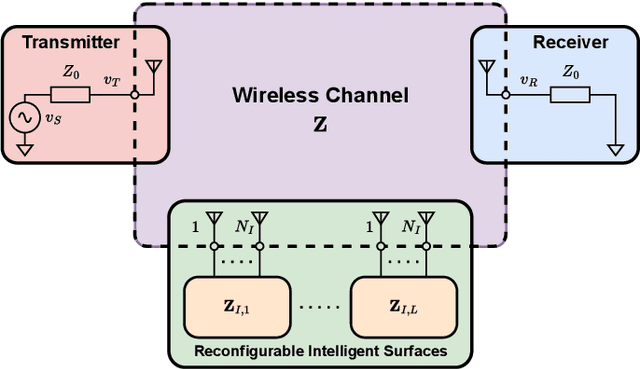

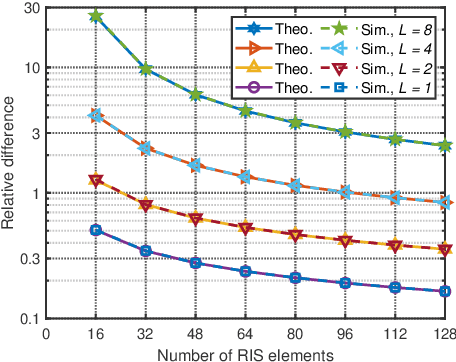
Abstract:Reconfigurable intelligent surface (RIS) is a revolutionary technology enabling the control of wireless channels and improving coverage in wireless networks. To further extend coverage, multi-RIS aided systems have been explored, where multiple RISs steer the signal toward the receiver via a multi-hop path. However, deriving a physics-compliant channel model for multi-RIS aided systems is still an open problem. In this study, we fill this gap by modeling multi-RIS aided systems through multiport network theory, and deriving the scaling law of the physics-compliant channel gain. The derived physics-compliant channel model differs from the widely used model, where the structural scattering of the RISs is neglected. Theoretical insights, validated by numerical results, show a significant discrepancy between the physics-compliant and the widely used models. This discrepancy increases with the number of RISs and decreases with the number of RIS elements, reaching 200% in a system with eight RISs with 128 elements each.
An Overview of Electromagnetic Illusions: Empowering Smart Environments with Reconfigurable Metasurfaces
Apr 18, 2024
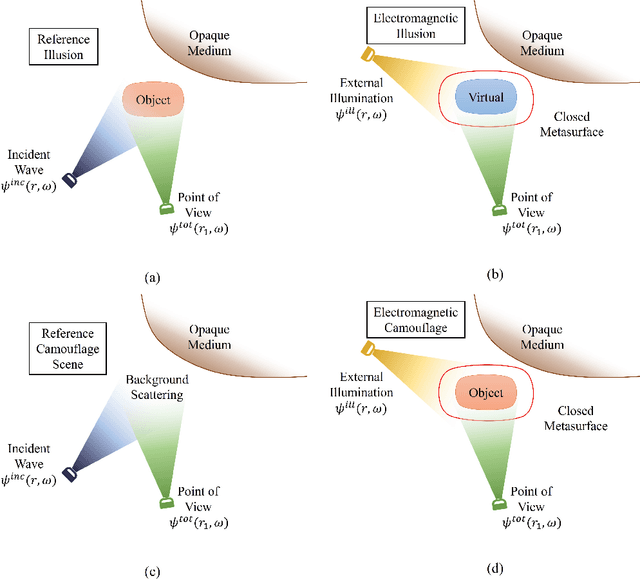
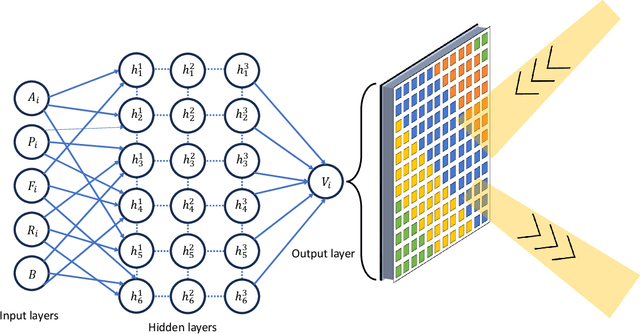
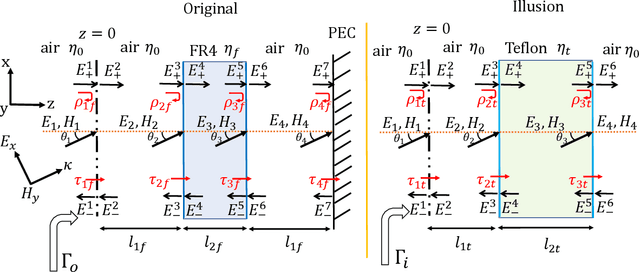
Abstract:This study delves into the innovative landscape of metasurfaces, with a particular focus on their role in achieving EM illusion (EMI) a facet of paramount significance. The control of EM waves assumes a pivotal role in mitigating issues such as signal degradation, interference, and reduced communication range. Furthermore, the engineering of waves serves as a foundational element in achieving invisibility or minimized detectability. This survey unravels the theoretical underpinnings and practical designs of EMI coatings, which have been harnessed to develop functional metasurfaces. EMI, practically achieved through engineered coatings, confers a strategic advantage by either reducing the radar cross-section of objects or creating misleading footprints. In addition to illustrating the outstanding achievements in reconfigurable cloaking, this study culminates in the proposal of a novel approach, suggesting the emergence of EMI without the need for physically coating the device to conceal and thus proposing the concept of a smart EMI environment. This groundbreaking work opens a new way for engineers and researchers to unlock exotic and versatile designs that build on reconfigurable intelligent surfaces (RIS). Crucially the designs enabled by the proposed approach, present a wide array of applications, encompassing camouflaging, deceptive sensing, radar cognition control, and defence security, among others. In essence, this research stands as a beacon guiding the exploration of uncharted territories in wave control through smart EMI environments, with profound implications spanning basic academic research in RIS through advanced security technologies and communication systems.
Empirical Validation of the Impedance-Based RIS Channel Model in an Indoor Scattering Environment
Dec 01, 2023Abstract:Ensuring the precision of channel modeling plays a pivotal role in the development of wireless communication systems, and this requirement remains a persistent challenge within the realm of networks supported by Reconfigurable Intelligent Surfaces (RIS). Achieving a comprehensive and reliable understanding of channel behavior in RIS-aided networks is an ongoing and complex issue that demands further exploration. In this paper, we empirically validate a recently-proposed impedance-based RIS channel model that accounts for the mutual coupling at the antenna array and precisely models the presence of scattering objects within the environment as a discrete array of loaded dipoles. To this end, we exploit real-life channel measurements collected in an office environment to demonstrate the validity of such a model and its applicability in a practical scenario. Finally, we provide numerical results demonstrating that designing the RIS configuration based upon such model leads to superior performance as compared to reference schemes.
Model-free Optimization and Experimental Validation of RIS-assisted Wireless Communications under Rich Multipath Fading
Feb 21, 2023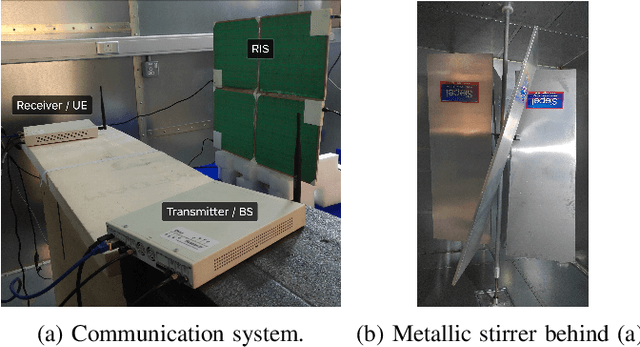
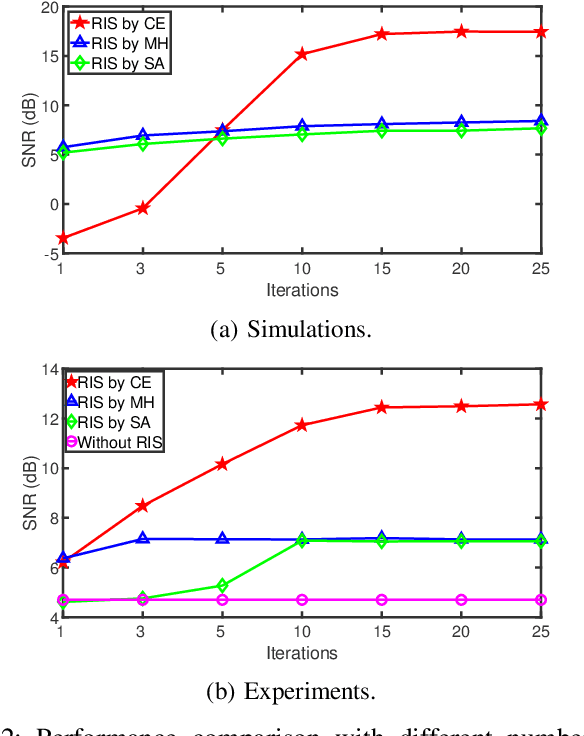
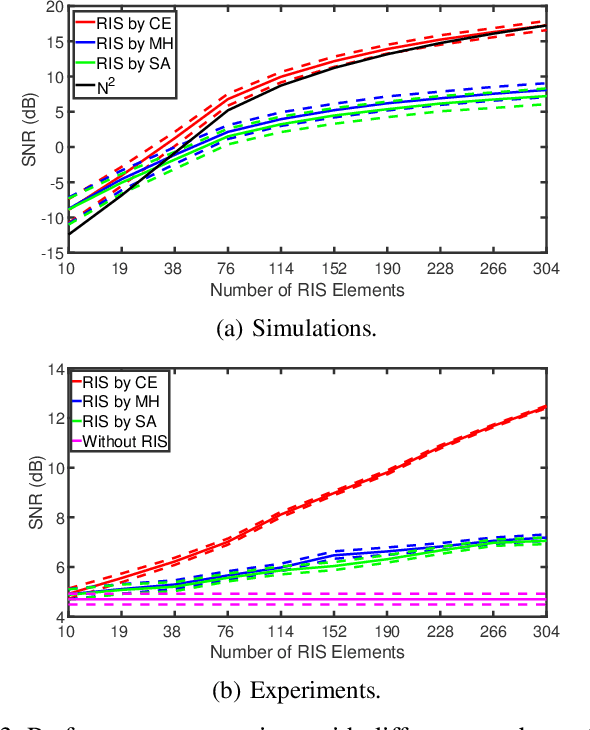
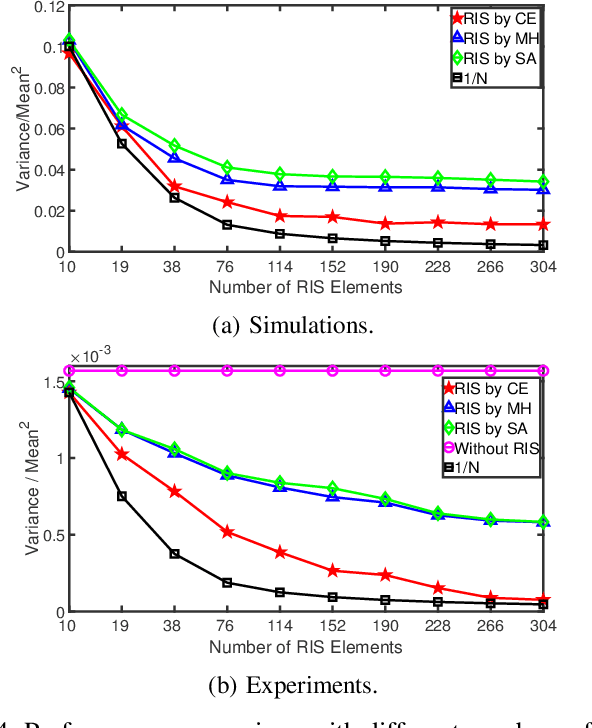
Abstract:Reconfigurable intelligent surface (RIS) devices have emerged as an effective way to control the propagation channels for enhancing the end users' performance. However, RIS optimization involves configuring the radio frequency (RF) response of a large number of radiating elements, which is challenging in real-world applications due to high computational complexity. In this paper, a model-free cross-entropy (CE) algorithm is proposed to optimize the binary RIS configuration for improving the signal-to-noise ratio (SNR) at the receiver. One key advantage of the proposed method is that it only needs system performance parameters, e.g., the received SNR, without the need for channel models or channel estimation. Both simulations and experiments are conducted to evaluate the performance of the proposed CE algorithm. The results demonstrate that the CE algorithm outperforms benchmark algorithms, and shows stronger channel hardening with increasing numbers of RIS elements.
Random Access Protocol with Channel Oracle Enabled by a Reconfigurable Intelligent Surface
Oct 09, 2022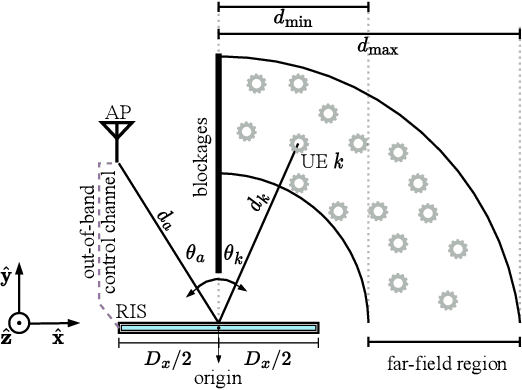



Abstract:The widespread adoption of Reconfigurable Intelligent Surfaces (RISs) in future practical wireless systems is critically dependent on the design and implementation of efficient access protocols, an issue that has received less attention in the research literature. In this paper, we propose a grant-free random access (RA) protocol for a RIS-assisted wireless communication setting, where a massive number of users' equipment (UEs) try to access an access point (AP). The proposed protocol relies on a channel oracle, which enables the UEs to infer the best RIS configurations that provide opportunistic access to UEs. The inference is based on a model created during a training phase with a greatly reduced set of RIS configurations. Specifically, we consider a system whose operation is divided into three blocks: i) a downlink training block, which trains the model used by the oracle, ii) an uplink access block, where the oracle infers the best access slots, and iii) a downlink acknowledgment block, which provides feedback to the UEs that were successfully decoded by the AP during access. Numerical results show that the proper integration of the RIS into the protocol design is able to increase the expected end-to-end throughput by approximately 40% regarding the regular repetition slotted ALOHA protocol.
2x2 MIMO Prototype for BER and EVM Measurements in Metal Enclosure
Sep 17, 2022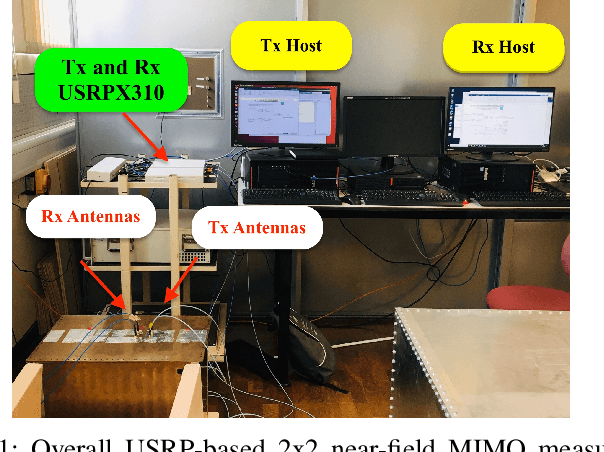
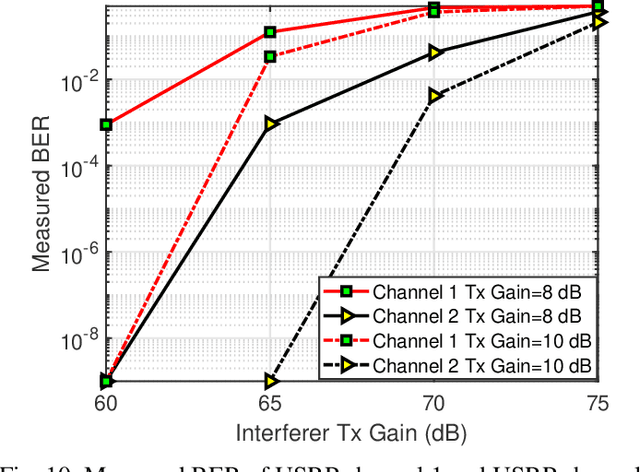
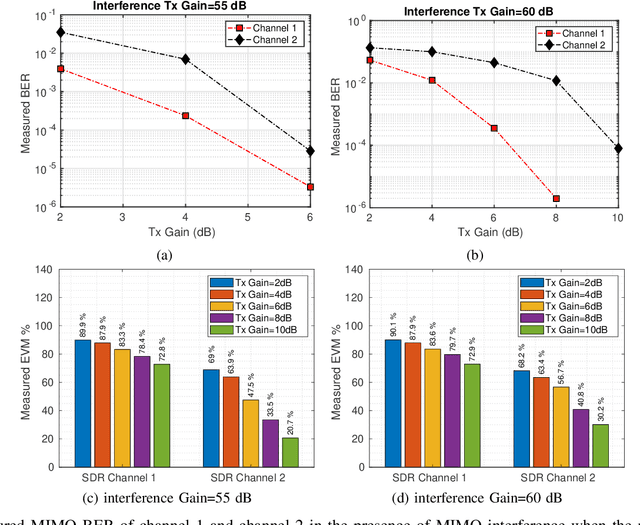
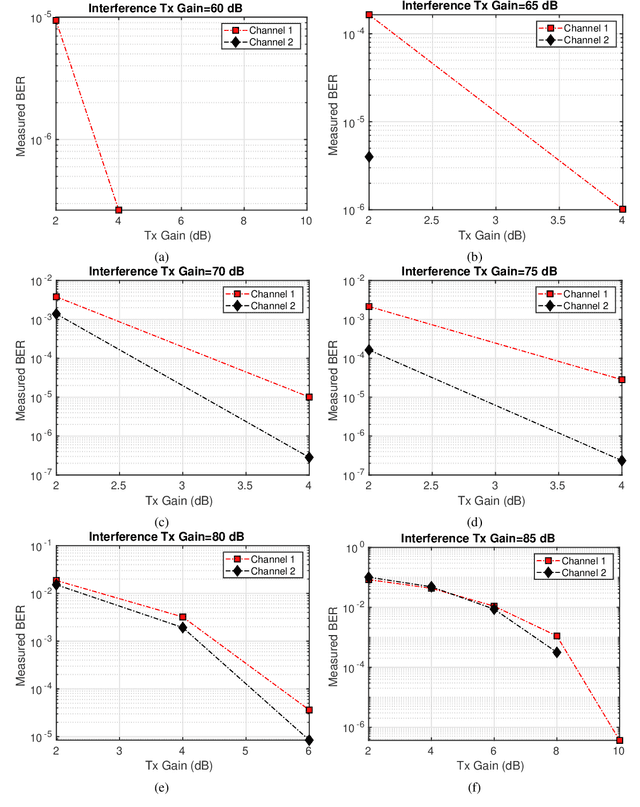
Abstract:In this work, we present a 2x2 near-field multi-input multiple-output (MIMO) prototype for bit-error-rate (BER) and error vector magnitude (EVM) measurements in a metal enclosure. The near-field MIMO prototype is developed using software-defined-radios (SDRs) for over-the-air transmission of QPSK modulated baseband waveforms. We check the near-field MIMO BER and EVM measurements in three different scenarios in a highly reflecting metal enclosure environment. In the first scenario, the line-of-sight (LOS) communication link is investigated when the mode-stirrer is stationary. In stationary channel conditions near-field MIMO BER and EVM measurements are performed. In the second scenario, BER and EVM measurements are performed in dynamic channel conditions when the mode-stirrer is set to move continuously. In the third scenario, LOS communication near-field MIMO BER and EVM measurements are performed in stationary channel conditions but now in the presence of MIMO interference. In three different scenarios, near-field MIMO BER and EVM measurements are investigated at different Tx USRP gain values and in the presence of varying levels of MIMO interference.
Reconfigurable Intelligent Surface-assisted Classification of Modulations using Deep Learning
Sep 17, 2022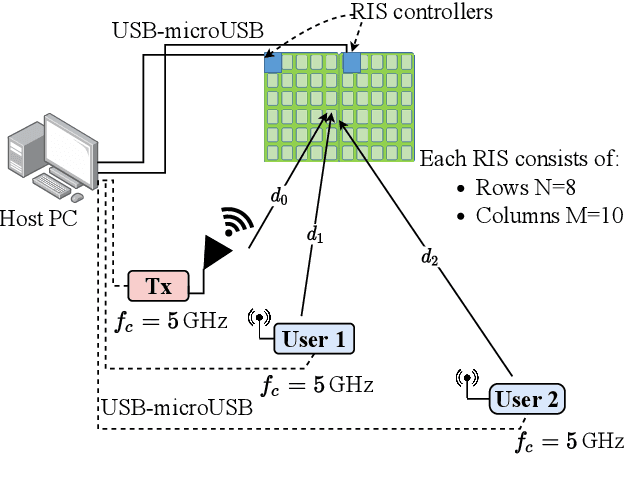
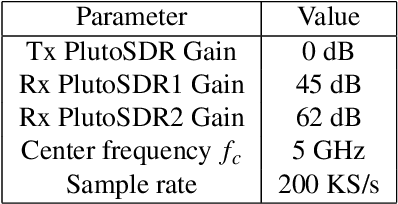
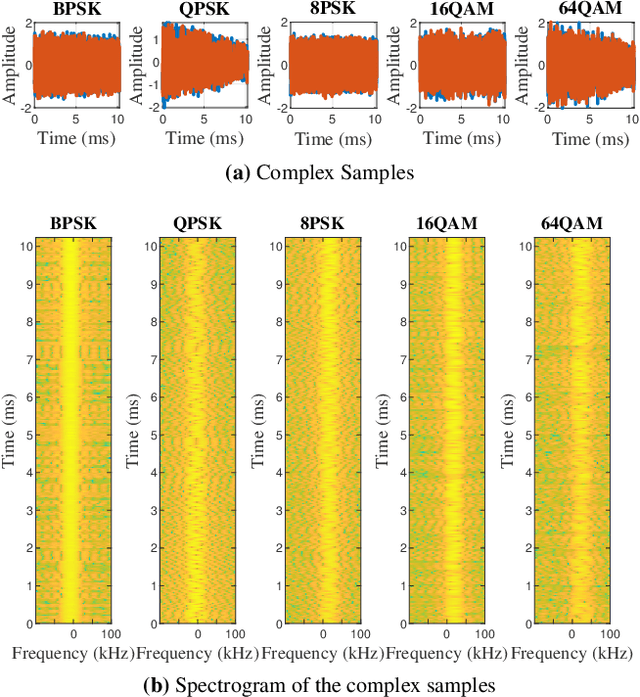
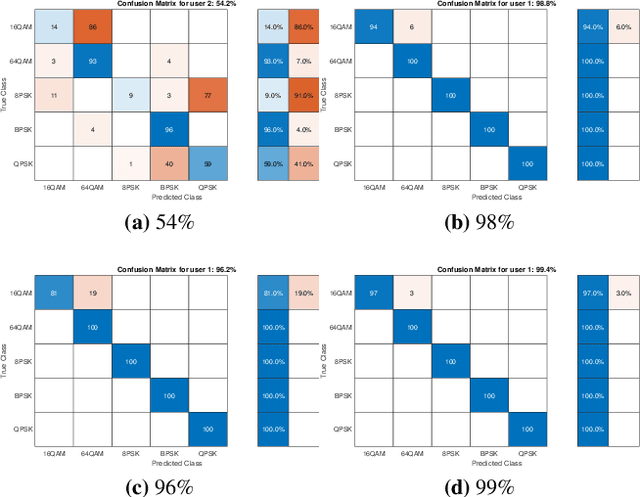
Abstract:The fifth generating (5G) of wireless networks will be more adaptive and heterogeneous. Reconfigurable intelligent surface technology enables the 5G to work on multistrand waveforms. However, in such a dynamic network, the identification of specific modulation types is of paramount importance. We present a RIS-assisted digital classification method based on artificial intelligence. We train a convolutional neural network to classify digital modulations. The proposed method operates and learns features directly on the received signal without feature extraction. The features learned by the convolutional neural network are presented and analyzed. Furthermore, the robust features of the received signals at a specific SNR range are studied. The accuracy of the proposed classification method is found to be remarkable, particularly for low levels of SNR.
 Add to Chrome
Add to Chrome Add to Firefox
Add to Firefox Add to Edge
Add to Edge